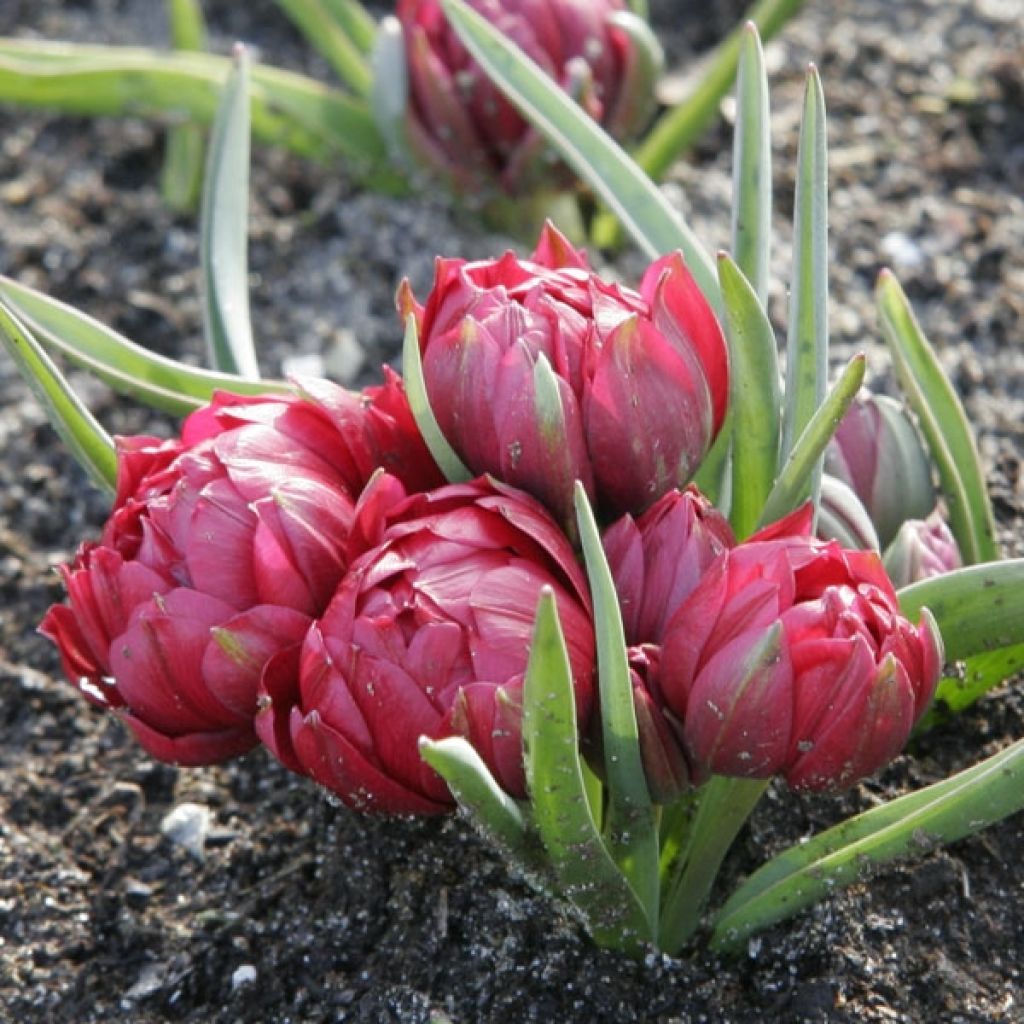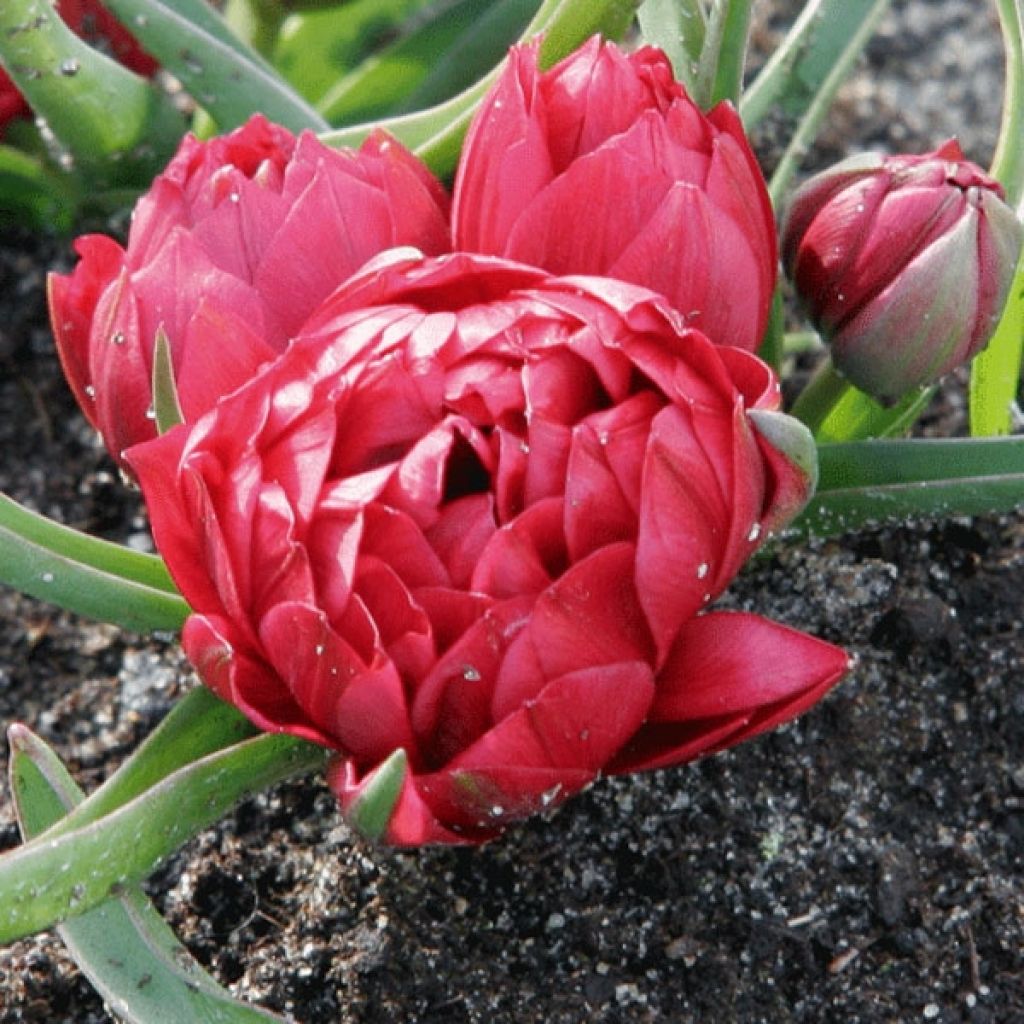

Tulipe Botanique humilis Tête à Tête


Tulipe Botanique humilis Tête à Tête
Tulipa humilis 'Tête-à-tête'
Tulipa humilis subsp. pulchella Tête à Tête
This plant carries a 6 months recovery warranty
More information
We guarantee the quality of our plants for a full growing cycle, and will replace at our expense any plant that fails to recover under normal climatic and planting conditions.
From €5.90 for pickup delivery and €6.90 for home delivery
Express home delivery from €8.90.
Does this plant fit my garden?
Set up your Plantfit profile →
Description
As small as it may be, the 'Tête-à-tête' Botanical Tulip stands out from all others with its double flowers of intense red-purple, which do not go unnoticed in rock gardens. Each short stem unfolds early in spring several flowers in small pompoms that reveal late a violet or midnight blue throat depending on the observer. They emit a unique fragrance, both peppery and sweet. The leaves, linear and shiny green, sometimes appear after flowering. Originating from Turkey and Iran, it is a very resistant plant, adapted to poor soils and arid conditions that naturalizes easily in the garden.
The Tulipa humilis 'Tête-à-tête' belongs to the Liliaceae family. It is a recent hybrid, derived from Tulipa humilis, a botanical species whose origins are lost between the Caucasus, Turkey, Iran, Syria, Lebanon, Israel, and northern Russia. Tulipa humilis has an extremely variable appearance depending on its origin. The 'Tête-à-tête' selection flowers in March-April, more or less early depending on the climate. It bears, at the end of a short flower stalk, not exceeding 15cm (6in), up to 5 flowers globular in shape, 6 to 10cm (2 to 4in) in diameter, composed of multiple rounded petals with pointed tips. The corolla opens in the sun, emitting a subtle, somewhat indescribable fragrance, but very pleasant. The bulbs are small, 3 to 4cm (1 to 2in) in diameter. This plant develops in late winter or early spring dark blue-green leaves, relatively narrow, sometimes almost curled, 10 to 15cm (4 to 6in) long. They dry up a few weeks after flowering, when the bulb enters a dormant state. Varieties of Tulipa humilis are not afraid of dry soils in summer and winter, quite the contrary.
Tulipa humilis 'Tête-à-tête' is indeed a little gem, but it is also a reliable and faithful plant, which will naturally find its place in a rock garden, along a path, or on a slightly wild slope, even if it is rather dry in summer and winter. Far from the calyxes of its lofty Dutch relatives, its peony-like flowers at ground level bring life to flower beds, early in spring, accompanied by crocuses. It adapts well to pot or container cultivation, allowing one to enjoy its radiant and delicately scented flowering up close.
Botanical tulips, and very similar tulips like this selection, do not "degenerate" over time, they naturalize and can remain in place for several years without specific maintenance and thrive in borders and rock gardens. To create colourful scenes, they can be associated with various small bulb plants: Ipheion uniflorum, Anemone blanda, Cyclamen coum, Erythronium pagoda, Leucojum vernum…
Report an error about the product description
Plant habit
Flowering
Foliage
Botanical data
Tulipa
humilis subsp. pulchella
Tête à Tête
Liliaceae
Cultivar or hybrid
Planting and care
Plant your Tulipa humilis 'Tête-à-tête' tulips as soon as possible in a well-drained soil. Loosen the soil deeply. Plant at a depth of 6-8cm (2-3in) (Bulbs should be covered with twice their height of soil). Space the bulbs a few cm apart, making sure they do not touch each other. Choose a sunny location for better flowering. After flowering, cut the flower stalks and allow the leaves to completely dry before cutting them. Flowering Carpet Tip You can create beautiful flowered spaces around the house, in flower beds, around trees, or in wild areas. It is an economical and sustainable solution, provided you follow a few principles: 1) It is a planting to leave in place. 2) Choose the varieties carefully according to the specific research area. 3) A resting period is essential after flowering for the bulbs to replenish. Allow the foliage to turn yellow and dry before cutting it. 4) Organic fertilizer should be spread once a year in autumn.
Planting period
Intended location
Care
-
, onOrder confirmed
Reply from on Promesse de fleurs
Haven't found what you were looking for?
Hardiness is the lowest winter temperature a plant can endure without suffering serious damage or even dying. However, hardiness is affected by location (a sheltered area, such as a patio), protection (winter cover) and soil type (hardiness is improved by well-drained soil).

Photo Sharing Terms & Conditions
In order to encourage gardeners to interact and share their experiences, Promesse de fleurs offers various media enabling content to be uploaded onto its Site - in particular via the ‘Photo sharing’ module.
The User agrees to refrain from:
- Posting any content that is illegal, prejudicial, insulting, racist, inciteful to hatred, revisionist, contrary to public decency, that infringes on privacy or on the privacy rights of third parties, in particular the publicity rights of persons and goods, intellectual property rights, or the right to privacy.
- Submitting content on behalf of a third party;
- Impersonate the identity of a third party and/or publish any personal information about a third party;
In general, the User undertakes to refrain from any unethical behaviour.
All Content (in particular text, comments, files, images, photos, videos, creative works, etc.), which may be subject to property or intellectual property rights, image or other private rights, shall remain the property of the User, subject to the limited rights granted by the terms of the licence granted by Promesse de fleurs as stated below. Users are at liberty to publish or not to publish such Content on the Site, notably via the ‘Photo Sharing’ facility, and accept that this Content shall be made public and freely accessible, notably on the Internet.
Users further acknowledge, undertake to have ,and guarantee that they hold all necessary rights and permissions to publish such material on the Site, in particular with regard to the legislation in force pertaining to any privacy, property, intellectual property, image, or contractual rights, or rights of any other nature. By publishing such Content on the Site, Users acknowledge accepting full liability as publishers of the Content within the meaning of the law, and grant Promesse de fleurs, free of charge, an inclusive, worldwide licence for the said Content for the entire duration of its publication, including all reproduction, representation, up/downloading, displaying, performing, transmission, and storage rights.
Users also grant permission for their name to be linked to the Content and accept that this link may not always be made available.
By engaging in posting material, Users consent to their Content becoming automatically accessible on the Internet, in particular on other sites and/or blogs and/or web pages of the Promesse de fleurs site, including in particular social pages and the Promesse de fleurs catalogue.
Users may secure the removal of entrusted content free of charge by issuing a simple request via our contact form.
The flowering period indicated on our website applies to countries and regions located in USDA zone 8 (France, the United Kingdom, Ireland, the Netherlands, etc.)
It will vary according to where you live:
- In zones 9 to 10 (Italy, Spain, Greece, etc.), flowering will occur about 2 to 4 weeks earlier.
- In zones 6 to 7 (Germany, Poland, Slovenia, and lower mountainous regions), flowering will be delayed by 2 to 3 weeks.
- In zone 5 (Central Europe, Scandinavia), blooming will be delayed by 3 to 5 weeks.
In temperate climates, pruning of spring-flowering shrubs (forsythia, spireas, etc.) should be done just after flowering.
Pruning of summer-flowering shrubs (Indian Lilac, Perovskia, etc.) can be done in winter or spring.
In cold regions as well as with frost-sensitive plants, avoid pruning too early when severe frosts may still occur.
The planting period indicated on our website applies to countries and regions located in USDA zone 8 (France, United Kingdom, Ireland, Netherlands).
It will vary according to where you live:
- In Mediterranean zones (Marseille, Madrid, Milan, etc.), autumn and winter are the best planting periods.
- In continental zones (Strasbourg, Munich, Vienna, etc.), delay planting by 2 to 3 weeks in spring and bring it forward by 2 to 4 weeks in autumn.
- In mountainous regions (the Alps, Pyrenees, Carpathians, etc.), it is best to plant in late spring (May-June) or late summer (August-September).
The harvesting period indicated on our website applies to countries and regions in USDA zone 8 (France, England, Ireland, the Netherlands).
In colder areas (Scandinavia, Poland, Austria...) fruit and vegetable harvests are likely to be delayed by 3-4 weeks.
In warmer areas (Italy, Spain, Greece, etc.), harvesting will probably take place earlier, depending on weather conditions.
The sowing periods indicated on our website apply to countries and regions within USDA Zone 8 (France, UK, Ireland, Netherlands).
In colder areas (Scandinavia, Poland, Austria...), delay any outdoor sowing by 3-4 weeks, or sow under glass.
In warmer climes (Italy, Spain, Greece, etc.), bring outdoor sowing forward by a few weeks.


































